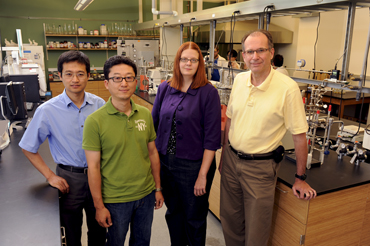June 20, 2011
Some of the tubes looked like they were holding very weak coffee. That meant microorganisms - in this case, Shewanella bacteria - were growing and biochemically converting sugars into hydrocarbons, said Jarboe, an Iowa State assistant professor of chemical and biological engineering.
Some of the sugars in those test tubes were produced by the fast pyrolysis of biomass. That's a thermochemical process that quickly heats biomass (such as corn stalks and leaves) in the absence of oxygen to produce a liquid product known as bio-oil and a solid product called biochar. The bio-oil can be used to manufacture fuels and chemicals; the biochar can be used to enrich soil and remove greenhouse gases from the atmosphere.
Iowa State's Hybrid Processing Laboratory on the first floor of the new, state-built Biorenewables Research Laboratory is all about encouraging that unique mix of biochemical and thermochemical technologies. The goal is for biologists and engineers to use the lab's incubators, reactors, gas chromatography instruments and anaerobic chambers to find new and better ways to produce biorenewable fuels and chemicals.
"Biological processes occur well below the boiling point of water, while thermal processes are usually performed hundreds of degrees higher, which makes it hard to imagine how these processes can be combined," said Robert C. Brown, an Anson Marston Distinguished Professor in Engineering, the Gary and Donna Hoover Chair in Mechanical Engineering, and the Iowa Farm Bureau Director of Iowa State's Bioeconomy Institute.

0 comments:
Post a Comment